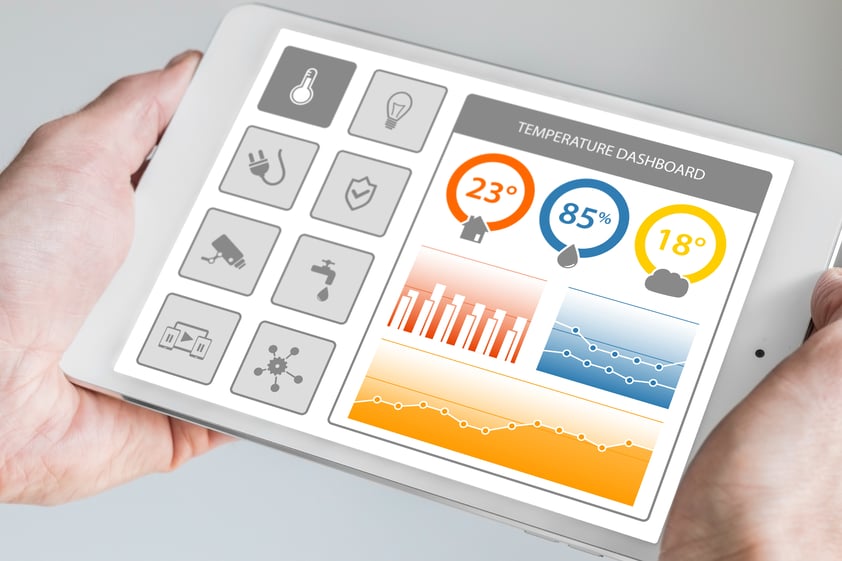
High standards within the hospitality and retail industries are crucial to success and profitability, from ensuring the best food quality and sustainability practices to streamlining operating costs – but how can this be achieved every time, without fail?
Clearly there’s a great deal of infrastructure involved from ovens to refrigerators and freezers, and these are crucial assets that ensure the best quality whilst playing a large role in sustainability. This equipment also makes up a high proportion of operating costs in energy usage, but are these systems operating at their most efficient level? The only way to ensure this 100% of the time is through smart condition monitoring systems that can help to transform quality and energy efficiency by alerting staff to any underperforming assets.
Monitoring assets in this way allows businesses to view a complete picture of asset performance, and understand if there are any issues, before these escalate into bigger problems. For example, if a refrigerator keeps dropping to a potentially incorrect and unsafe temperature, the monitoring solution will send out an alert to ensure this is looked at before it potentially fails overnight and wastes large quantities of food, costing the business in stock value and customer satisfaction.
Alarms of this nature can be quickly distributed to response teams so that issues can be dealt with in a timely manner and situations managed. Wired sensors are not overly suitable for such environments, for instance in fridges and freezers having a wired sensor would require a gap in the seal to allow an exit/entrance port for the cable, or it would enter from the door and so compromise the temperature. Instead, wireless sensors are the much smarter option, automatically transmitting the data to a cloud platform (via a 2G, 3G, 4G or broadband gateway) that compiles the data and presents it for full transparency, to registered users across any device.
Not only does this prevent the costly disasters of spoiled food but it reduces the manual element of maintaining these systems. As per compliance standards, readings must be taken several times each day to check the temperatures are correct, taking valuable time out of people’s days to manually test and report. In addition, this method isn’t necessarily that accurate, after all, temperature read-outs in older style units can “drift” at 0.5°C per annum, and 50% of LED readings on the outside of fridges and freezers are materially wrong. However, with automatic temperature monitoring, this is performed quickly, easily and much more frequently and accurately to ensure optimum efficiency across the board.
In today’s day and age sustainability is a key focus on the journey to decarbonisation, and the efficient use of energy systems is a core part of this. 63% of energy use is electricity for heating and cooling systems, and so clearly these assets can cost businesses and our planet a significant amount if they’re not operating at their optimum efficiency. By having condition monitoring in place, the system can automatically flag if the unit is drawing more power than usual, a sign that maintenance is required, preventing issues ahead of time and allowing for engineers to improve the efficiency of equipment to streamline costs and sustainability.
Not only does this help the industry, but food quality can drastically improve through advanced monitoring systems, for example ice cream and yoghurt needs to be kept at specific temperatures and can suffer from overchilling which ruins the quality of the product and reduces customer satisfaction. Overchilling also costs businesses unnecessarily through energy costs. For each 1°C a fridge or freezer overchills, energy use and cost increase by 2.5% to 4% per degree, but with monitoring, this can be avoided and the automatic data retrieval by the sensors ensures that cooling assets remain at the correct temperature.
Managing larger quantities of assets also becomes significantly easier through automatic wireless sensors, because the data can be sent over long range frequencies and so the gateway where the data is processed can be far away and can cope with multiple data transmissions at any one time if there are multiple assets in the area. Costs are low with this type of smart technology too, particularly compared to the clear cost-savings that can be leveraged from streamlining systems in this way.
This technology stretches beyond temperature monitoring too, with options such as CO2 monitoring, the opening and closing of doors, energy consumption, power consumption and lots of other types that help to streamline processes and optimise efficiency within the estate.
Across the many appliances that businesses have, these incremental temperature differences and all the extra minutes of electrical unit operation add up, but by unlocking the visibility of the entire infrastructure through wireless sensor monitoring there are clear cost-savings and quality of food can be drastically improved, whilst importantly boosting energy efficiency and sustainability. It gives managers the power to see their assets in full and it provides the blueprint for proactive and corrective adjustments. Parameters can be set, and if assets go above or below these thresholds an alarm will be activated by the sensors to ensure the problem is visible straight away, before it becomes costly. It’s non-invasive, secure, and also provides a reference point when looking at new equipment and technologies. The benefits certainly stack up, and this technology can be implemented quickly and easily to leverage smarter working across the industry.



